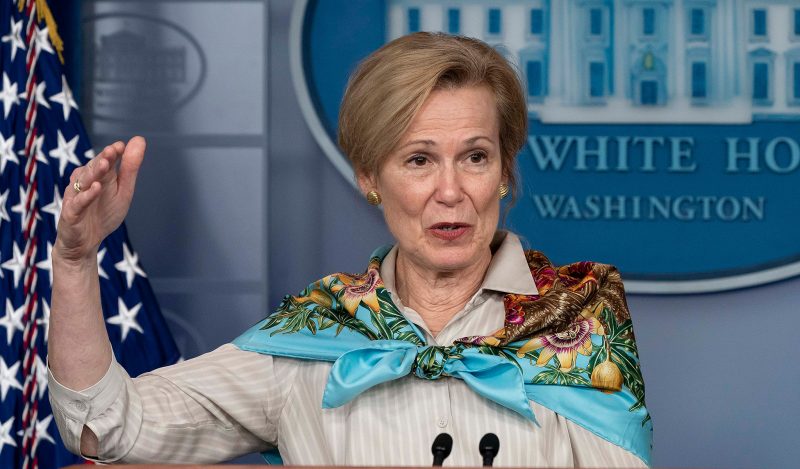In three previous articles, I explored the puzzles of Dr. Deborah Birx’s appointment to the White House Coronavirus Response Task Force, her dubious scientific claims, and the people and groups she may or may not have worked with. In order to make sense of all the inconsistencies and incongruities that emerged, I hypothesized that Birx probably had ties to a group of military/intelligence/biosecurity actors who wanted to cover up a lab leak of an engineered virus – a group I am calling “the lab-leak cabal.”
It is my (as yet unproven) theory that the lab-leak cabal, for which Birx was a primary agent in the US government, wanted to impose strict lockdowns all over the world. Why they wanted lockdowns may include any or all of the following:
- The cabal, in tandem with Chinese authorities, wanted to divert attention from their culpability in creating a deadly and highly infectious virus that escaped into the world’s population.
- Population exposure to an enhanced pandemic potential pathogen was unprecedented, so they felt it had to be countered with unprecedented containment measures, on an unprecedented scale.
- China said their lockdowns were working to stop the virus, and the cabal really wanted to believe China that lockdowns could work if they were strict and long enough.
- They saw the pandemic as an opportunity to test their ideas and experiment with tactics for global crisis management, including lockdowns, rapid vaccine manufacture and distribution, real-time surveillance of individuals and entire populations, media manipulation and other novel solutions waiting for a catastrophic problem.
Whatever their motives, the goal seems very clear: Get as many countries as possible to lock down for as long as possible, at least until vaccines became available.
But locking down entire countries full of healthy populations was never an accepted or ethically/medically/scientifically supported pandemic response, and people might object to such draconian measures. So Birx+cabal had to create enough panic to make it happen.
What, then, was their strategy?
An outsider unknowingly provides the lockdown blueprint
In his scathing account of his time on the Task Force, A Plague Upon Our House, Dr. Scott Atlas – the only outsider I’m aware of who managed to penetrate the Task Force’s inner workings – uses phrases like “Kafkaesque absurdity,” “incomprehensible error,” and “frankly immoral” to describe what he witnessed. Indeed, if the Task Force had actually been trying to apply best practices to pandemic mitigation, then everything they did would seem incomprehensibly misguided and obviously terrible – as it did to Atlas.
However, if you believe (as I do) that Birx was imposing the lab-leak cabal’s agenda on the Task Force and the country (and, by extension, the world), then everything they did suddenly makes perfect sense: All the policies that seemed ridiculous when examined separately worked splendidly together to whip up massive panic, which in turn induced global compliance with draconian lockdowns.
In other words, each anti-scientific, non-public-health measure in itself – e.g., universal cloth masking, testing and quarantining after the virus was widespread, focusing on cases instead of hospitalizations or deaths – was not intended to achieve anything, except the singular goal of fomenting massive fear. And the purpose of the fear was to ensure maximum compliance with lockdowns.
Which brings us back to Scott Atlas, who inadvertently, in decrying the Task Force’s terrible policies and behaviors, managed to reveal the outline of their hidden agenda.
Based on Atlas’s astute observations of Birx and Co.’s worst practices, I have compiled a ten-step list of instructions for how to get the world to comply with totalitarian lockdown policies in response to a not-very-devastating pandemic.
[ALL QUOTES ARE FROM ATLAS’S BOOK, KINDLE VERSION]
- Whip up as much fear as possible. If you want entire populations to agree to prolonged draconian lockdowns that have never been used or tested before, then people have to be really, really, really scared.
[ATLAS REPORTING A CONVERSATION WITH DR. ANTHONY FAUCI]
“I challenged him to clarify his point, because I couldn’t believe my ears. ‘So you think people aren’t frightened enough?’ He said, ‘Yes, they need to be more afraid.’ To me, this was another moment of Kafkaesque absurdity. I replied, ‘I totally disagree. People are paralyzed with fear. Fear is one of the main problems at this point.’ Inside, I was also shocked at his thought process, as such an influential face of the pandemic. Instilling fear in the public is absolutely counter to what a leader in public health should do. To me, it is frankly immoral.” (p. 186)
“All internal meetings involving Birx were filled with warnings and exhortations advocating locking society down, although never using those words.” (p. 131)
- Insist that the virus is unlike any other. The unknown is always scarier than what we know. Plus, if we cannot apply anything we know about any other viruses, then we can justify any untested, unprecedented response we choose.
“Perhaps the most fundamental error that went unchallenged was the World Health Organization’s initial characterization of this virus as entirely new. Even its name—novel coronavirus—implied that we knew nothing about it in terms of its causes, effects, and management protocols. That ‘novelty’ also implied that no one would have any immune-system protection from it.” (p. 32)
“That mischaracterization helped incite panic and was fundamental to prompting the ensuing draconian lockdowns.” (pp. 32-33)
2a) Insist that natural immunity does not apply. If this virus is unlike any other, then maybe exposure to it does not confer immunity as exposure to every other virus does.
“Today, as the world still struggles with the biological truth of the importance of natural immunity as part of herd immunity, I contemplate why it was viewed as some sort of diabolical term. But it’s clear to see why it was employed by those clinging to lockdowns at all costs. Casting herd immunity as reckless and dangerous was unethical, but ultimately even more effective than simple character assassination for a political purpose. Of all the cynical ways to manipulate people, fear was their best way to maintain lockdowns, despite the massive destruction from lockdowns that regular people saw before their own eyes.” (p. 374)
- Emphasize how little we know and how uncertain we are about the virus. Neither past experiences nor real-time data can allay fears, because we know nothing about this virus and will continue to know nothing until we somehow manage to crush it.
“There was no articulation of what we knew, what the scientific studies and the world’s evidence had shown. On the contrary, Fauci repeatedly emphasized in his occasional Task Force comments, as he did in his frequent media interviews, what we did not know with certainty, just as a layman without any medical perspective would do. For instance, the issue of risk to children, or spread from children to adults, was always, ‘Well, we don’t know for sure,’ despite repeated studies from all over the world elucidating that we did know.
That pattern of highlighting uncertainties while minimizing decades of fundamental immunology and virology was alarmist and contrary to the expected behavior of a public health leader. It created massive fear inside and outside the White House, and it drove on-the-ground lockdowns and mandates.” (pp. 167-168)
3a) Use only worst-case scenario models to determine policy. No real-world data can ever apply to a novel virus about which we know nothing, and worst-case scenarios are usefully terrifying.
“Suddenly, computer modelers and people without any perspective about clinical illnesses were dominating the airwaves. Along with millions of Americans, I began witnessing unprecedented responses from those in power and nonscientific recommendations by public health spokespeople… These recommendations were not just based on panic; they were responsible for generating even more panic.” (p. 25)
“Regardless of the obvious and continual failures of statistical models, the prominent display of those same models in the media continued…The discussion about models represents one of the early displays of groupthink in this pandemic. The repetition of misinformation from many voices became accepted as truth. Media outlets and prominent policymakers clung to those same failed models, and they kept inciting panic.” (p. 319)
- Ignore all previous medical, scientific and public health knowledge and guidelines.
“The more I studied the data and the literature, the more obvious it became that basic biology and simple logic were missing from the discussion. Instead, fear had seemingly displaced critical thinking about the data already at hand. No one seemed to remember many fundamentals of science taught in college and medical school.” (p. 26)
4a) Impose medically and scientifically bunk mandates that serve only to signal a never-ending state of emergency.
“Masks were already proven to be ineffective for influenza, a virus of similar size. That had been reviewed by the CDC in May 2020 and by Oxford University’s Centre for Evidence-Based Medicine in July 2020. The empirical evidence from the US and all over the world already had shown masks failed to stop COVID-19 cases from surging.” (pp. 331-2)
“Relying on masks would be dangerous, implying protection for those at risk to die, like the vulnerable elderly, when legitimate protection was not conferred. Requiring masks would also increase the fear, as a visible public reminder of the ‘extreme danger.’” (p. 332)
- Do not consult anyone who applies traditional pandemic response standards, including world experts who conduct scientific, medical and ethical/economic/social risk-benefit analyses.
“It was baffling to me, an incomprehensible error of whoever assembled the Task Force, that there were zero public health policy experts and no experts with medical knowledge who also analyzed economic, social, and other broad public health impacts other than the infection itself. Shockingly, the broad public health perspective was never part of the discussion among the Task Force health advisors other than when I brought it up. Even more bizarre was that no one seemed to notice.” (p. 107)
“In the end, the most egregious failure of the Task Force was its complete and utter disregard for the harmful impact of its recommended policies. This was outright immoral, an inexplicable betrayal of their most fundamental duty.” (p. 151)
- Insist on testing everyone all the time regardless of symptoms and regardless of how much the virus has already spread.
“Testing for this virus had turned into a national, indeed, international obsession.” (p. 103)
“This was diagnostic testing, with broad-reaching policy aims. In this pandemic, a positive test was a major driver of the policy of quarantining and isolating healthy people with low-risk profiles—shuttering businesses, closing schools—in short, a key to locking down the country.” (p. 107)
“Mass testing of low-risk people in low-risk environments was the inevitable pathway to lockdowns, and lockdowns were destructive.” (p. 116)
6a) Crank up the tests to diagnostically useless levels, so the numbers of seemingly positive cases are always sky-high.
“PCR tests were the basis of defining cases, and the basis for quarantines, but most were misleading. Using a PCR ‘cycle threshold’ of thirty-five—even lower than the thirty-seven to forty cycles used routinely to detect the virus—fewer than 3 percent of “positives” contain live, contagious virus, as reported by Clinical Infectious Diseases. Even the New York Times wrote in August that 90 percent or more of positive PCR tests falsely implied that someone was contagious. Sadly, during my entire time at the White House, this crucial fact would never even be addressed by anyone other than me…” (pp. 113-114)
- Insist that the only relevant metric is case counts. The more cases you count, the worse the pandemic is, the more scared people are, the longer lockdowns continue.
“Their strange shift from flattening the curve to maintaining that we must stop all cases of COVID-19, at all costs, was firmly set in stone.” (p. 160)
“Of the first 11,000 ‘cases’ as defined by positive tests, zero were hospitalized. Soon over 25,000 cases—positive tests in mostly asymptomatic students—had been registered. Yet with all those ‘cases,’ zero hospitalizations—no illnesses requiring significant medical care. My view was that there was an alarming disconnect between the data on risk to college-age individuals and the policies being implemented.” (p. 204)
- Insist that the virus is very dangerous for everyone. If you admit that certain demographic groups have a lower risk, people will not be scared enough.
“Even allowing for a non-expert level of knowledge, the Task Force doctors somehow ignored the evidence indicating the very low risk from this infection for the overwhelming majority of people. Birx even emphasized at the Task Force that this infection was extremely dangerous exactly because it was so commonly asymptomatic.” (p. 167)
“The medical science was consistent from the early days of the pandemic that even seasonal influenza is more dangerous to young children than this coronavirus. This perspective would have been enormously reassuring to parents, yet it was never put forth by those dominating the public narrative.” (p. 321)
- Treat politicians and the general population as children requiring your guidance. Once they’re scared enough, you become the trustworthy authority figure who tells them what to do.
“It was my impression that most governors sincerely wanted assistance on designing their states’ response; instead, they were receiving basic admonitions and unscientific rules, as though they were children.” (p. 180)
- Never admit your policies cause any harm. Insist to everyone (including yourself) that without them millions would have died.
“I never fully understood why there was no admission, even internally by the Task Force, that the Birx-Fauci strategy did not work.” (p. 237)
“To this day, I cannot understand why the human cost of the lockdowns never mattered to anyone else on the Task Force. It was never brought up while I was there, not a single doctor ever spoke of it. The media continues to ignore perhaps the most remarkable insight in the Fauci email trove discovered under FOIA in June 2021—the total lack of mention of harms from the lockdown throughout the pandemic.” (pp. 240-241)
CONCLUSION
Dr. Scott Atlas was appalled at what he considered gross errors and unethical behavior on the part of the White House Coronavirus Task Force doctors, led by Dr. Deborah Birx. He could not comprehend how medical professionals, like himself, could impose such disastrous policies.
The questions Atlas raises are ones with which I, too, struggled for much of the pandemic:
- Why was the public not told about the steep age gradient of the virus?
- Why were parents not reassured that their children were at lower risk from this virus than from the flu?
- Why was natural immunity not just dismissed but suddenly considered an immoral “policy?”
- Why were we testing and quarantining long after it was clearly useless in terms of slowing the spread?
- Why were case counts, based on obviously bogus positive test results, considered a more important metric than hospitalizations and deaths?
I am deeply grateful to Atlas for his insights and inside reporting from the Task Force, because in raising these questions, he also inadvertently helped me come up with an answer: Everything Birx and the Task Force (and the lab-leak cabal I posit behind them) did was meant to foment fear, leading to compliance with unprecedented, untested, and predictably unsuccessful – not to mention enormously destructive – global lockdowns.
Atlas knew that fear was the tool they were using, but he could not understand how they could do so in good conscience. Nor can I.
“Using emotional distress as a tool to ensure greater adherence to government policy is immoral in public health, yet fear was consciously leveraged by those most influencing the citizenry.” (p. 348)
“Of all the cynical ways to manipulate people, fear was their best way to maintain lockdowns, despite the massive destruction from lockdowns that regular people saw before their own eyes.” (p.374)
Only through exposing the real motives behind this egregiously immoral behavior by global “public health” leaders that we can delegitimize their entire panic/lockdown enterprise, thereby hopefully lowering the chances of it happening again.
Published under a Creative Commons Attribution 4.0 International License
For reprints, please set the canonical link back to the original Brownstone Institute Article and Author.









